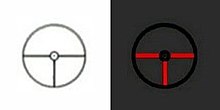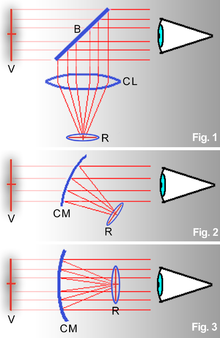Reticle
This articleneeds additional citations forverification.(February 2009) |



Areticle,orreticule[1][2]also known as agraticule,is a pattern of fine lines or markings built into theeyepieceof anoptical devicesuch as atelescopic sight,spotting scope,theodolite,optical microscopeor thescreenof anoscilloscope,to providemeasurement referencesduringvisual inspections.Today, engraved lines or embedded fibers may be replaced by adigital imagesuperimposed on a screen or eyepiece. Both terms may be used to describe any set of patterns used for aiding visualmeasurementsandcalibrations,but in modern usereticleis most commonly used forweaponsights,whilegraticuleis more widely used for non-weaponmeasuring instrumentssuch asoscilloscope display,astronomic telescopes,microscopesandslides,surveying instrumentsand other similar devices.
There are many variations of reticle pattern; this article concerns itself mainly with the most rudimentary reticle: thecrosshair.Crosshairs are typically represented as a pair ofperpendicularlyintersecting lines in the shape of a cross, "+", though many variations of additional features exist including dots,posts,concentriccircles/horseshoes,chevrons,graduated markings,or a combination of above. Most commonly associated with telescopic sights for aimingfirearms,crosshairs are also common in optical instruments used forastronomyandsurveying,and are also popular ingraphical user interfacesas a precisionpointer.The reticle is said to have been invented byRobert Hooke,and dates to the 17th century.[3]Another candidate as inventor is the amateur astronomerWilliam Gascoigne,who predated Hooke.[4]
Uses[edit]
Firearms[edit]
Telescopic sights for firearms, generally just calledscopes,are probably the device most often associated with crosshairs.Motion picturesand the media often use a view through crosshairs as a dramatic device, which has given crosshairs wide cultural exposure.
Reticle shape[edit]
While the traditional thin crossing lines are the original and still the most familiar cross-hair shape, they are really best suited for precision aiming at high contrast targets, as the thin lines are easily lost in complex backgrounds, such as those encountered while hunting. Thicker bars are much easier to discern against a complex background, but lack the precision of thin bars. The most popular types of cross-hair in modern scopes are variants on theduplexcross-hair, with bars that are thick on the perimeter and thin out in the middle. The thick bars allow the eye to quickly locate the center of the reticle, and the thin lines in the center allow for precision aiming. The thin bars in a duplex reticle may also be designed to be used as a measure. Called a 30/30 reticle, the thin bars on such a reticle span 30 minutes of arc (0.5º), which is approximately equal to 30 inches (76 cm) at 100 yards (91 m). This enables an experienced shooter to deduce, on the basis of the known size of an object in view, (as opposed to guess or estimate) the range within an acceptable error limit.
Wire crosshairs[edit]

Originally crosshairs were constructed out of hair or spiderweb, these materials being sufficiently thin and strong. Many modern scopes use wire crosshairs, which can be flattened to various degrees to change the width. These wires are usually silver in color, but appear black when backlit by the image passing through the scope's optics. Wire reticles are by nature fairly simple, as they require lines that pass all the way across the reticle, and the shapes are limited to the variations in thickness allowed by flattening the wire; duplex crosshairs, and crosshairs with dots are possible, and multiple horizontal or vertical lines may be used. The advantage of wire crosshairs is that they are fairly tough and durable, and provide no obstruction to light passing through the scope.
Etched reticles[edit]

The first suggestion for etched glass reticles was made byPhilippe de La Hirein 1700.[5]His method was based on engraving the lines on a glass plate with adiamondpoint. Many modern crosshairs are actuallyetchedonto a thin plate ofglass,which allows a far greater latitude in shapes. Etched glass reticles can havefloatingelements, which do not cross the reticle; circles and dots are common, and some types of glass reticles have complex sections designed for use inrange estimationand bullet drop and drift compensation (seeexternal ballistics). A potential disadvantage of glass reticles is that the surface of the glass reflects some light (about 4% per surface on uncoated glass[6]) lessening transmission through the scope, although this light loss is near zero if the glass is multicoated (coating being the norm for all modern high quality optical products).
Illuminated reticles[edit]
Reticles may be illuminated, either by a plastic orfiber opticlight pipecollecting ambient light or, in low light conditions, by abatterypoweredLED.Some sights also use the radioactive decay oftritiumfor illumination that can work for 11 years without using a battery, used in the BritishSUSATsight for theSA80(L85) assault rifle and in the AmericanACOG (Advanced Combat Optical Gunsight).Red is the most common color used, as it is the least destructive to the shooter'snight vision,but some products use green or yellow illumination, either as a single colour or changeable via user selection.
Graticule[edit]
A graticule is another term for reticle, frequently encountered in British and British military technical manuals, and came into common use duringWorld War I.[7]
Reticle focal plane[edit]
The reticle may be located at the front or rear focal plane (First Focal Plane (FFP) or Second Focal Plane (SFP))[8]of the telescopic sight. On fixed power telescopic sights there is no significant difference, but on variable power telescopic sights the front plane reticle remains at a constant size compared to the target, while rear plane reticles remain a constant size to the user as the target image grows and shrinks. Front focal plane reticles are slightly more durable, but most American users prefer that the reticle remains constant as the image changes size, so nearly all modern American variable power telescopic sights are rear focal plane designs.[citation needed]American and European high end optics manufacturers often leave the customer the choice between a FFP or SFP mounted reticle.
Collimated reticles[edit]

Collimated reticles are produced by non-magnifying optical devices such asreflector sights(often calledreflex sights) that give the viewer an image of the reticle superimposed over the field of view, and blindcollimator sightsthat are used with both eyes. Collimated reticles are created usingrefractiveorreflectiveoptical collimatorsto generate acollimatedimage of an illuminated or reflective reticle. These types of sights are used on surveying/triangulating equipment, to aid celestial telescope aiming, and assightsonfirearms.Historically they were used on larger military weapon systems that could supply an electrical source to illuminate them and where the operator needed a wide field of view to track and range a moving target visually (i.e. weapons from the prelaser/radar/computerera). More recently sights using low power consumption durablelight emitting diodesas the reticle (calledred dot sights) have become common on small arms with versions like theAimpoint CompM2being widely fielded by the U.S. Military.
Holographic reticles[edit]
Holographic weapon sightsuse aholographicimage of a reticle at finite set range built into the viewing window and acollimatedlaser diodeto illuminate it. An advantage to holographic sights is that they eliminate a type ofparallaxproblem found in some optical collimator based sights (such as thered dot sight) where the spherical mirror used inducesspherical aberrationthat can cause the reticle to skew off the sight'soptical axis.The use of a hologram also eliminates the need for image dimming narrow band reflective coatings and allows for reticles of almost any shape ormilsize. A downside to the holographic weapon sight can be the weight and shorter battery life. As with red dot sights, holographic weapon sights have also become common on small arms with versions like theEotech512.A65 and similar models fielded by the U.S. Military[9]and various law enforcement agencies.
Surveying and astronomy[edit]
In older instruments, reticle crosshairs and stadia marks were made using threads taken from thecocoonof thebrown recluse spider.This very fine, strong spider silk makes for an excellent crosshair.[10][11]
Surveying[edit]
In surveying, reticles are designed for specific uses.Levelsandtheodoliteswould have slightly different reticles. However, both may have features such asstadia marksto allow distance measurements.
Astronomy[edit]
For astronomical uses, reticles could be simple crosshair designs or more elaborate designs for special purposes. Telescopes used forpolar alignmentcould have a reticle that indicates the position ofPolarisrelative to the north celestial pole. Telescopes that are used for very precise measurements would have afilar micrometeras a reticle; this could be adjusted by the operator to measure angular distances between stars.
For aiming telescopes,reflex sightsare popular, often in conjunction with a small telescope with a crosshair reticle. They make aiming the telescope at anastronomical objecteasier.
The constellationReticulumwas designated to recognize the reticle and its contributions to astronomy.
See also[edit]
- Adrien Auzout
- Deflection (ballistics)
- Focusing screen– used in photography, and often etched
- Iron sight
- List of astronomical instruments
- Photomask– partial plate with holes or transparencies used in photolithography integrated circuit fabrication is also called a "reticle"
- Sniper
- Target blip
- Parallax
References[edit]
- ^A Christopher Gorse, David Johnston, Martin Pritchard, Dictionary of Construction, Surveying and Civil Engineering (2 ed.), Oxford University Press, 2020– reticule
- ^dictionary – reticule
- ^ McIntyre, Thomas (2007).The Field & Stream Hunting Optics Handbook.Globe Pequot. p. 118.
- ^Sellers, David."Serendipity and a Spider William Gascoigne (c.1612-44) and the Invention of the Telescope Micrometer".magavelda.Retrieved4 November2019.
- ^Maurice Daumas,Scientific Instruments of the Seventeenth and Eighteenth Centuries and Their Makers,Portman Books, London 1989ISBN978-0-7134-0727-3
- ^Richard Feynman, the red books
- ^Glazebrook, Sir Richard, A Dictionary of Applied Physics, Macmillan and Co., London, 1923.
- ^"First vs Second Focal Plane – What is the Differences?".25 July 2022.
- ^"Holographic Sights for SOCOM M4s".Retrieved30 August2012.
- ^Raymond Davis, Francis Foote, Joe Kelly,Surveying, Theory and Practice,McGraw-Hill Book Company, 1966 LC 64-66263
- ^Berenbaum, May R.,Field Notes - Spin Control,The Sciences, The New York Academy Of Sciences, September/October 1995
